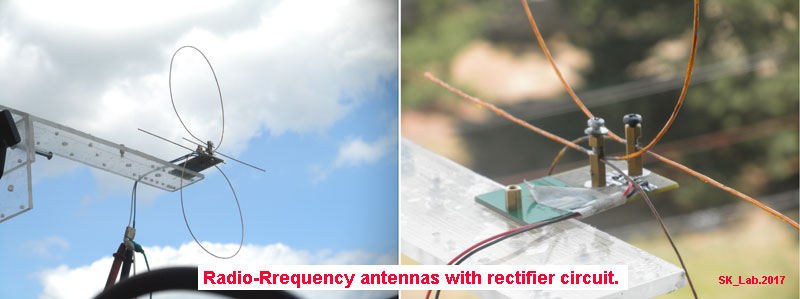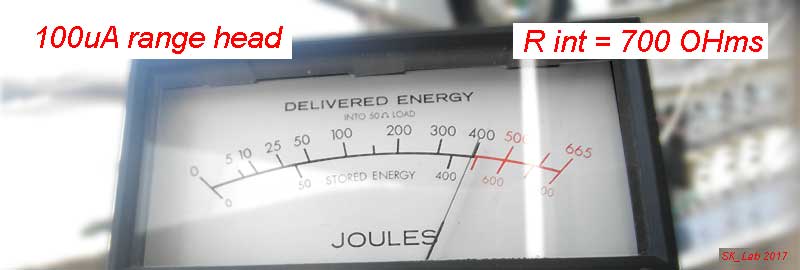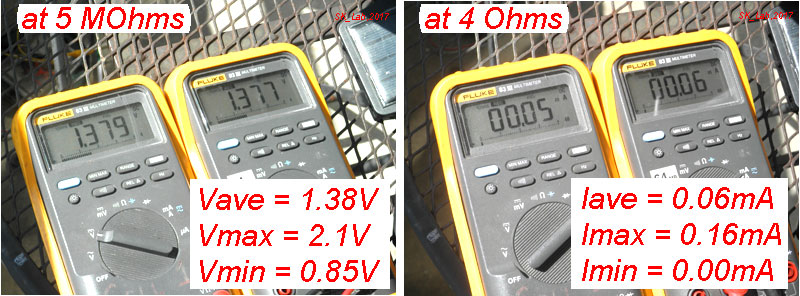
Simply, I like to check things.
Harvesting power from radio waves.
Assuming that most people came here to just find out how much energy can be obtained from radio waves, we will be short.
On the banner, two 'Dual-Loop' directional antennas, designed specifically to collect power at 750MHz. One is connected to 100uA (700Ohms) head, and the average current you can see on it. Both antennas have 'on-board' rectifiers.

Reality is not as good as we would like. One antenna produces about 1 volt (at 10MOhms), and a current of about 0,4 mA (at 700OHms).
The circuit is simple as a crystal receiver. Diodes with capacitors work as a voltage doubler (rectifier). The remaining inductors and capacitors isolate the output from high frequency.

Any RF diodes with junction capacitance less then 1.5pF will be suitable for this application. See the end of this page for a suitable choice.
It's hard to believe, but the old style panel meter is the best indicator of the power that was obtained.

After simple calculations, the total power, received at the moment, is about 0.5mW.
It was a good, top result. But interesting to know what average power can be expected. A simple installation allows me to get more reliable results. We measure the open voltage (at 5 MOhms) and short current (at 4 Ohms) produced by one antenna. The measurement time for obtaining the average is about half an hour. Both multimeters work together to eliminate an accidental error.

And here we return to reality. During the measurement time, the average power taken from the air by one antenna was ~0.02mW. Even the fact that the maximum power jumped to ~0.8 mW did not change anything.
For most people, these digits do not say anything. So let's move on to the practical side.
Suppose you want to light the LED. 0.02mW is not enough to light the LED even very, very dimly. One way to do this is to charge the capacitor and when enough energy is stored, discharge it through the LED.
Let's say you want to light a white LED (3V), with a current of 0.01A, for 0.1 second. It requires 3V*0.01A*0.1sec.= 0.003Joule. The antenna produces, an average, 0.00002W*1sec.=0.00002J each second. This means that to get the necessary energy (0.003J), you need to wait 150 seconds or 2.5 minutes.
*** Added: in reality, it takes 2-3 times more, to get 0.003J. ***
But it is not all that bad. During the 24 hours, this simple setup with one antenna, can collect about 1.7J of totally free energy. This is enough that a data logger would work, and once a day transmit data via wireless or so. For example, a device (or LED) consuming 10mA at 3.6V can run at least 45 seconds per day on the stored energy.
In order to make this idea run, in your particular case, you need to:
a) find a 'hot spot' using any RF detector (this one works for me);
b) with any SDR Receiver find RF frequency with max. power (any cheep RTL-SDR is good enough);
c) make a simple antenna (Dual-Loop or so), add RF rectifier and enjoy 'free' energy :)
a) find a 'hot spot' using any RF detector (this one works for me);
b) with any SDR Receiver find RF frequency with max. power (any cheep RTL-SDR is good enough);
c) make a simple antenna (Dual-Loop or so), add RF rectifier and enjoy 'free' energy :)
Yes. It's all. It's simple like that.
1. A good article, about radio emission in London UK,( pdf): 'Ambient RF Energy Harvesting in Urban and Semi-Urban'.
2. Some practical data. In this case, this antenna charges a block of 0.036F capacitors. How long?
3. Harvesting power from radio waves. From 750MHz, TV broadcasting.
4. Calculating RF power at a distance from TX antenna is easier than it seems. Briefly, how to ... (not ready).
_